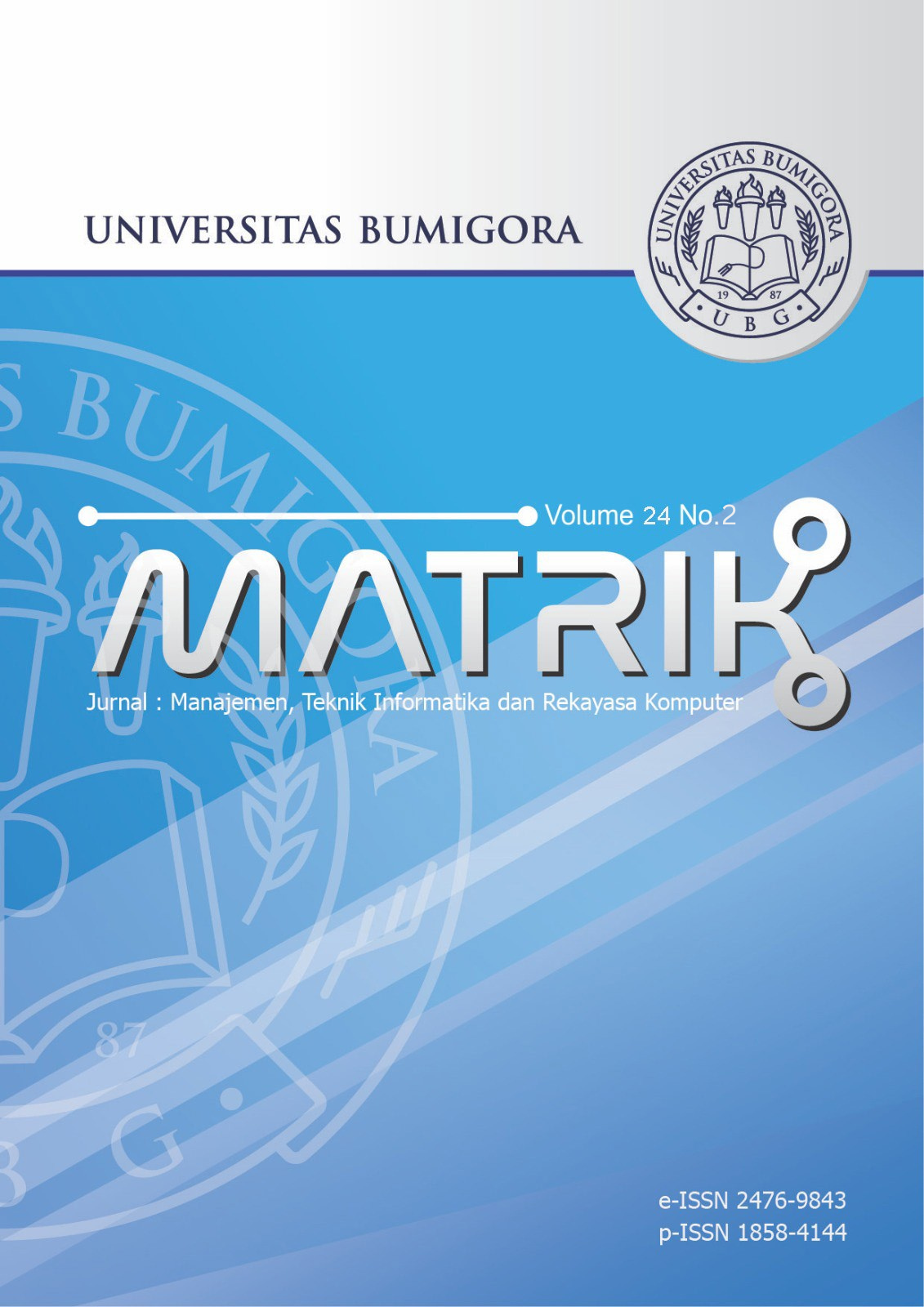Determining Toddler's Nutritional Status with Machine Learning Classification Analysis Approach
DOI:
https://doi.org/10.30812/matrik.v24i2.4092Keywords:
Analysis model, Classification, Machine learning, Nutritional status, ToddlersAbstract
The nutritional status of toddlers is a common issue many countries face worldwide. Various facts indicate that malnutrition is a primary focus for many researchers. Several efforts have been made to address this problem, including developing analytical models for identification, classification, and prediction. This study aims to evaluate the nutritional status of children by utilizing a classification analysis approach using Machine Learning. This research aims to improve the accuracy of the classification system and facilitate better decision-making in stunted toddlers, which is a priority, especially in the health sector. The Machine Learning classification analysis process will later utilize the performance of the Naive Bayes algorithm, the Support Vector Machine algorithm, and the Multilayer Perceptron algorithm. ML performance can be optimized using gridsearchCV to produce optimal classification analysis patterns. The data set of this study uses 6812 toddler data sourced from the Health Center at the Tangerang Regency Health Office. Based on the research presented, Machine Learning performance in analyzing nutritional status classification provides maximum results. The results are reported based on a precision level with an accuracy of 88%. The results of this analysis can also present a classification of nutritional status based on knowledge. This study can contribute to and update the analysis model in determining nutritional status. The results of this study can also provide benefits in handling nutritional status problems that occur in children.
Downloads
References
Research in Medical & Health Science (ISSN: 2208-2425), vol. 9, no. 7, pp. 25–30, 2023, https://doi.org/10.53555/nnmhs.v9i7.
1751.
[2] H. Shi, D. Yang, K. Tang, C. Hu, L. Li, L. Zhang, T. Gong, and Y. Cui, “Explainable machine learning model for predicting
the occurrence of postoperative malnutrition in children with congenital heart disease,†Clinical Nutrition, vol. 41, no. 1, pp.
202–210, 2022, https://doi.org/10.1016/j.clnu.2021.11.006.
[3] I. Soesanti, “Komitmen Pimpinan pada Penurunan Stunting di Kabupaten Tuban Jawa Timur,†Media Gizi Indonesia (National
Nutrition Journal) Special Issue: International Conference on Stunting 2022, vol. 17, no. 1, pp. 211–214, 2024, https://doi.org/
10.20473/mgi.v17i1SP.211-214.
[4] F. Maula Hidayat, Kusrini, and Ainul Yaqin, “Penerapan Algoritma Na¨ıve Bayes Untuk Klasifikasi Status Gizi Stunting Pada
Balita,†Dielektrika, vol. 11, no. 2, pp. 107–118, 2024, https://doi.org/10.29303/dielektrika.v11i2.384.
[5] S. Melyani, S. Z. Harahap, and I. Irmayanti, “Prediction of Stunting in Toddlers Combining the Naive Bayes Method and the
C4.5 Algorithm,†Sinkron, vol. 8, no. 2, pp. 1160–1168, 2024, https://doi.org/10.33395/sinkron.v8i2.13651.
[6] A. Rozaq and A. J. Purnomo, “Classification of Stunting Status in Toddlers using Naive Bayes Method in The City of Madiun
Based on Website,†Jurnal Techno Nusa Mandiri, vol. 19, no. 2, pp. 69–76, 2022, https://doi.org/10.33480/techno.v19i2.3337.
[7] F. T. Sabilillah, C. A. Sari, R. B. Abiyyi, and Y. P. Astuti, “Comparison of Machine Learning Algorithms on Stunting Detection
for ’ Centing ’ Mobile Application to Prevent Stunting,†vol. 8, no. 4, pp. 2361–2368, 2024, https://doi.org/10.33395/sinkron.
v8i4.13967.
[8] S. Y. Andriyani, M. S. Lydia, and S. Efendi, “Optimization of Support Vector Machine Algorithm Using Stunting Data Classification,â€
Prisma Sains : Jurnal Pengkajian Ilmu dan Pembelajaran Matematika dan IPA IKIP Mataram, vol. 11, no. 1, p. 164,
2023, https://doi.org/=10.33394/j-ps.v11i1.6619.
[9] I. A. Cahyani, P. I. Ashuri, C. Sri, and K. Aditya, “Stunting Disease Classification Using Multi- Layer Perceptron Algorithm
with GridSearchCV,†SinkrOn, vol. 8, no. 1, pp. 392–401, 2024, https://doi.org/10.33395/sinkron.v9i1.13245.
[10] S. P. Manongga, H. Hendry, and D. H. F. Manongga, “Predicting a Stunting Prevalence Using Semi-Supervised Learning Models
in East Nusa Tenggara,†ICIC Express Letters, vol. 19, no. 4, pp. 1073–1086, 2023, https://doi.org/10.24507/ijicic.19.04.1073.
[11] M. G. Rojas, A. C. Olivera, and P. J. Vidal, “Optimising Multilayer Perceptron weights and biases through a Cellular Genetic
Algorithm for medical data classification,†Array, vol. 14, no. January, pp. 1–15, 2022, https://doi.org/10.1016/j.array.2022.
100173.
[12] K. Gohari, A. Kazemnejad, M. Mohammadi, F. Eskandari, S. Saberi, M. Esmaieli, and A. Sheidaei, “A Bayesian latent class
extension of naive Bayesian classifier and its application to the classification of gastric cancer patients,†BMC Medical Research
Methodology, vol. 23, no. 1, pp. 1–15, 2023, https://doi.org/10.1186/s12874-023-02013-4.
[13] S. M. Rahman, N. A. Ahmed, M. M. Abedin, B. Ahammed, M. Ali, M. J. Rahman, and M. Maniruzzaman, “Investigate the
risk factors of stunting, wasting, and underweight among under-five Bangladeshi children and its prediction based on machine
learning approach,†PLoS ONE, vol. 16, no. 6 June 2021, pp. 1–11, 2021, https://doi.org/10.1371/journal.pone.0253172.
[14] T. Nguyen, K. Mengersen, D. Sous, and B. Liquet, “SMOTE-CD: SMOTE for compositional data,†PLoS ONE, vol. 18, no. 6
June, pp. 1–19, 2023, https://doi.org/10.1371/journal.pone.0287705.
[15] G. Wang, B. Zhao, B. Wu, C. Zhang, and W. Liu, “Intelligent prediction of slope stability based on visual exploratory data
analysis of 77 in situ cases,†International Journal of Mining Science and Technology, vol. 33, no. 1, pp. 47–59, 2023, https:
//doi.org/10.1016/j.ijmst.2022.07.002.
[16] P. P. Allorerung, A. Erna, and M. Bagussahrir, “Analisis Performa Normalisasi Data untuk Klasifikasi K-Nearest Neighbor pada
Dataset Penyakit,†JISKA (Jurnal Informatika Sunan Kalijaga), vol. 9, no. 3, pp. 178–191, 2024, https://doi.org/10.14421/jiska.
2024.9.3.178-191.
[17] L. Yuningsih, G. A. Pradipta, D. Hermawan, P. D. W. Ayu, D. P. Hostiadi, and R. R. Huizen, “IRS-BAG-Integrated Radius-
SMOTE Algorithm with Bagging Ensemble Learning Model for Imbalanced Data Set Classification,†Emerging Science Journal,
vol. 7, no. 5, pp. 1501–1516, 2023, https://doi.org/10.28991/ESJ-2023-07-05-04.
[18] J. H. Joloudari, A. Marefat, M. A. Nematollahi, S. S. Oyelere, and S. Hussain, “Effective Class-Imbalance Learning Based on
SMOTE and Convolutional Neural Networks,†Applied Sciences (Switzerland), vol. 13, no. 6, pp. 2–34, 2023, https://doi.org/
10.3390/app13064006.
[19] L. D. Cahya, A. Luthfiarta, J. I. T. Krisna, S. Winarno, and A. Nugraha, “Improving Multi-label Classification Performance on
Imbalanced Datasets Through SMOTE Technique and Data Augmentation Using IndoBERT Model,†Jurnal Nasional Teknologi
dan Sistem Informasi, vol. 9, no. 3, pp. 290–298, 2024, https://doi.org/10.25077/TEKNOSI.v9i3.2023.290-298.
[20] S. Rana and A. K. Gautam, “K-Fold Cross-Validation through Identification of the Opinion Classification Algorithm for the
Satisfaction of University Students,†International Journal of Online and Biomedical Engineering, vol. 19, no. 9, pp. 122–130,
2023, https://doi.org/10.3991/ijoe.v19i11.39887.
Downloads
Published
Issue
Section
License
Copyright (c) 2025 Taufik Hidayat, Mohammad Ridwan, Muhamad Fajrul Iqbal, Muhammad Ivan Corddoba, Nursiwa Eka Putra, William Eric Manongga

This work is licensed under a Creative Commons Attribution-ShareAlike 4.0 International License.
How to Cite
Similar Articles
- Edi Ismanto, Januar Al Amien, Vitriani Vitriani, A Comparison of Enhanced Ensemble Learning Techniques for Internet of Things Network Attack Detection , MATRIK : Jurnal Manajemen, Teknik Informatika dan Rekayasa Komputer: Vol. 23 No. 3 (2024)
- F.ti Ayyu Sayyidul Laily, Didik Dwi Prasetya, Anik Nur Handayani, Tsukasa Hirashima, Revealing Interaction Patterns in Concept Map Construction Using Deep Learning and Machine Learning Models , MATRIK : Jurnal Manajemen, Teknik Informatika dan Rekayasa Komputer: Vol. 24 No. 2 (2025)
- lili Tanti, Syahril Efendi, Maya Silvi Lydia, Herman Mawengkang, Model Dynamic Facility Location in Post-Disaster Areas in Uncertainty , MATRIK : Jurnal Manajemen, Teknik Informatika dan Rekayasa Komputer: Vol. 22 No. 1 (2022)
- Jaka Tirta Samudra, Rika Rosnelly, Zakarias Situmorang, Comparative Analysis of SVM and Perceptron Algorithms in Classification of Work Programs , MATRIK : Jurnal Manajemen, Teknik Informatika dan Rekayasa Komputer: Vol. 22 No. 2 (2023)
- Frans Mikael Sinaga, Sio Jurnalis Pipin, Sunaryo Winardi, Karina Mannita Tarigan, Ananda Putra Brahmana, Analyzing Sentiment with Self-Organizing Map and Long Short-Term Memory Algorithms , MATRIK : Jurnal Manajemen, Teknik Informatika dan Rekayasa Komputer: Vol. 23 No. 1 (2023)
- Bambang Krismono Triwijoyo, Ahmat Adil, Anthony Anggrawan, Convolutional Neural Network With Batch Normalization for Classification of Emotional Expressions Based on Facial Images , MATRIK : Jurnal Manajemen, Teknik Informatika dan Rekayasa Komputer: Vol. 21 No. 1 (2021)
- Miftahus Sholihin, Mohd Farhan Bin Md. Fudzee, Lilik Anifah, A Novel CNN-Based Approach for Classification of Tomato Plant Diseases , MATRIK : Jurnal Manajemen, Teknik Informatika dan Rekayasa Komputer: Vol. 24 No. 3 (2025)
- Angelina Ervina Jeanette Egeten, Siska A. Damanik, Ika Agustina, Marcelina Panggabean, Perancangan Sistem Informasi Posyandu Berbasis Web Pada Yayasan Kalyanamitra Di Jakarta Timur Untuk Mendukung Program Bidang Pendampingan Komunitas , MATRIK : Jurnal Manajemen, Teknik Informatika dan Rekayasa Komputer: Vol. 18 No. 2 (2019)
- Neny Sulistianingsih, Galih Hendro Martono, Enhancing Predictive Models: An In-depth Analysis of Feature Selection Techniques Coupled with Boosting Algorithms , MATRIK : Jurnal Manajemen, Teknik Informatika dan Rekayasa Komputer: Vol. 23 No. 2 (2024)
- Muhammad Zaki Wiryawan, Didik Dwi Prasetya, Anik Nur Handayani, Tsukasa Hirashima, Wahyu Styo Pratama, Lalu Ganda Rady Putra, Enhancing Semantic Similarity in Concept Maps Using LargeLanguage Models , MATRIK : Jurnal Manajemen, Teknik Informatika dan Rekayasa Komputer: Vol. 24 No. 3 (2025)
You may also start an advanced similarity search for this article.
Most read articles by the same author(s)
- Robby Rizky, Zaenal Hakim, Sri Setiyowati, Susilawati susilawati, Ayu Mira Yunita, Development of the Multi-Channel Clustering Hierarchy Method for Increasing Performance in Wireless Sensor Network , MATRIK : Jurnal Manajemen, Teknik Informatika dan Rekayasa Komputer: Vol. 23 No. 3 (2024)


.png)












